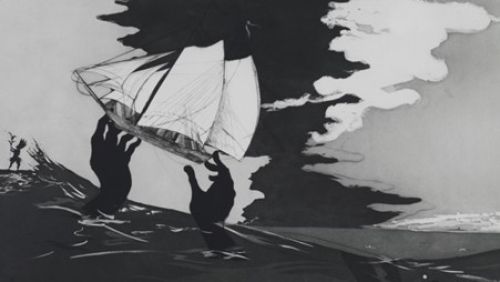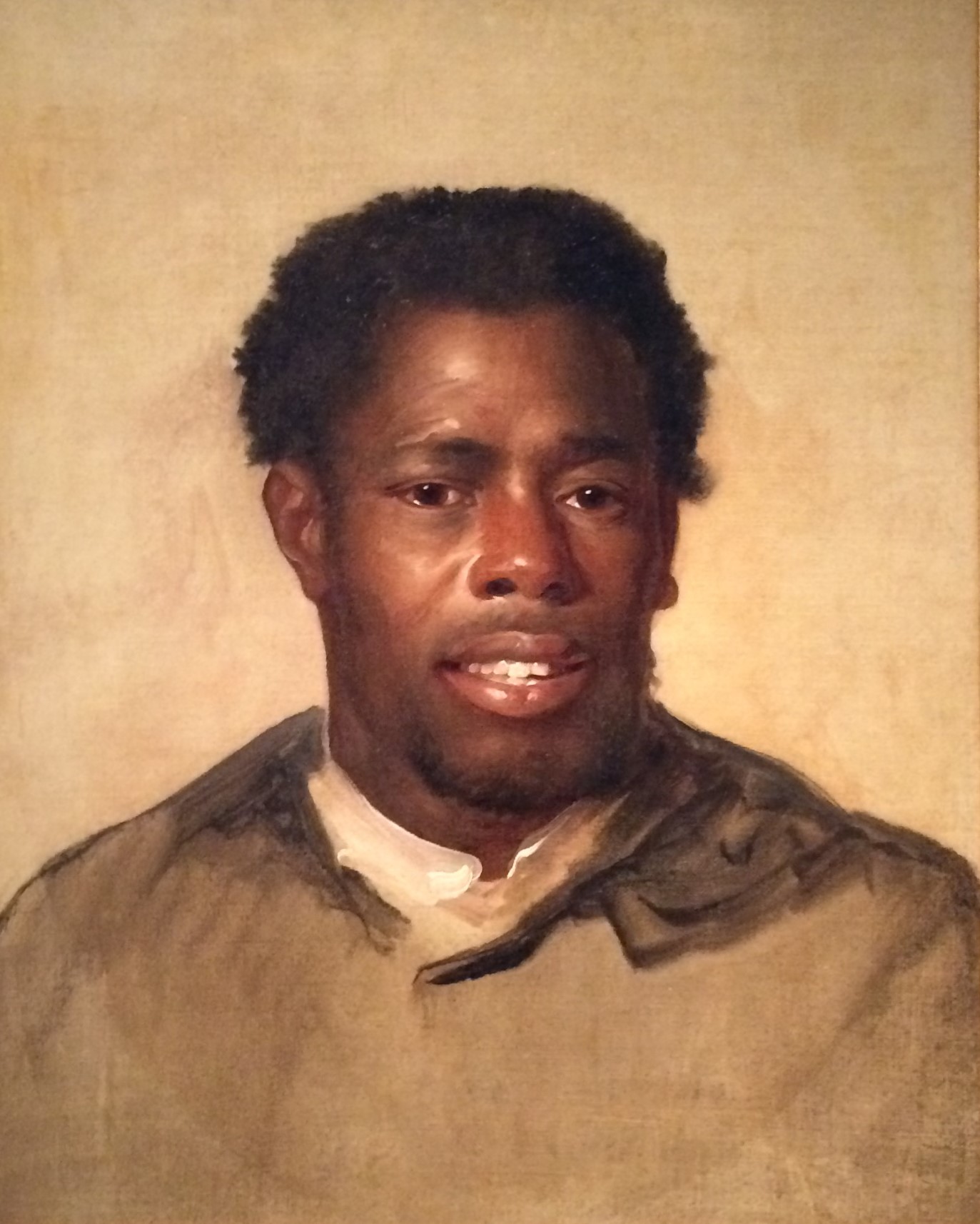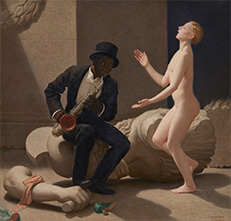Art, colonialism and change: 'Entangled Pasts' at the Royal Academy

Nick Moss reviews Art and Colonialism: Entangled Pasts 1768 - Now, Royal Academy of Arts to 29 April 2024
The premise of this exhibition is, according to the paper guide, to “explore connections between art associated with the Royal Academy and Britian’s colonial histories.” In fact it does this only at the most superficial level, if at all.
We are told that “Today, the legacies of colonial histories continue to form part of the fabric of everyday life, physically and emotionally, across social, economic, cultural and political fields both national and global.” The commentary fails to proceed from that banality to anything more incisive. We are simply invited to find in the visual and conceptual resonances between art and colonialism “a space for contemplation, inquiry, acknowledgement, reflection, imagination and ongoing conversations.” Which is nice, as Bill Murray once put it, in Caddyshack.
If you want more by way of banality, we then are told that “poetry and painting are sometimes called ‘sister arts’ ” and that RA summer exhibition artists sometimes selected excerpts of poetry or prose to frame the interpretation of their works. So “for this exhibition the RA has invited contemporary poets to respond to the works on display.”
All of which implies a lack of trust in the capacity of painting to speak for itself, and the ability of viewers to think for themselves. This isn't to denigrate the poetry – the poems by Imtiaz Dharker and Malika Booker in particular are powerful, and engage strikingly with the works on display, but the exhibition fails by trying to say at once both too much and too little.
There is surprisingly little engagement with the histories of the works on show, beyond brief biographical information about artist, and sometimes, the subjects. The wider history of the period when each work was produced is passed over, when more detail would have aided viewers in active engagement with the works. It is not sufficient to simply say the works are products of colonialism, as if the relations of production encompassed within the term are not varied and complex – including slavery, peasant labour, industrialism and post-abolition imperialism. Moreover, all of these were met with resistance, yet there is little of that resistance on display here.

The Death of General Wolfe, Benjamin West, 1770
I want to focus first on the works from the RA collection and then look at the works produced /exhibited by contemporary artists that respond to these. One of the most powerful works from the collection is Benjamin West’s The Death of General James Wolfe, which depicts a scene from the 1759 Battle of Quebec. The work features a First Nations (Delaware) figure, kneeling on the left side of the canvas – and we are told that this is “an idealised and exoticised representation of Indigenous people that helped shape viewers’ ideas about Indigenous peoples in North America.”
But West’s relation to the Native American subject is more complex than this allows. An autodidact, he at one point claimed that when he was a child, Native Americans showed him how to make paint by mixing some clay from the river bank with bear grease in a pot. West held that “Art is the representation of human beauty, ideally perfect in design, graceful and noble in attitude.”
The Death of General Wolfe tore up the rulebook of the day by having its subjects dressed in contemporary clothing – history paintings generally sought to idealise their subjects by dressing them in classical garb. We can assume therefore that West wanted his viewers to recognise the level of idealisation incorporated into the scene as no more than was required to draw out the tragic element at its core. The Native American mourner (is he in fact mourning at all, or simply observing?) is presumably, by virtue of inclusion, seen as part of the tableau of grace and nobility West sought here to represent, and the pose he has the figure adopt is thoughtful, pensive.
So is this really an idealised and exoticised representation of an Indigenous subject? Given Wolfe’s death scene is represented as a martial variant of a Christian pieta, and that West sought to portray his subjects per se as “ideally perfect in design”, we can say that by idealising the Indigenous figure West includes him within his tableau of human beauty, all here faced with a battlefield tragedy . Thus, while the role of the Indigenous guide/warrior is one produced by a particular set of colonial power relations, West’s painting may document those relations, but it does not appear to reproduce them at the level of representation. The figure is included within the circle of mourning subjects. If he is idealised, then he is so as part of a similarly idealised group. This is a point I want to argue for throughout the exhibition.

I want to look now at John Singleton Copley’s 1777/78 Head of a Man (above). The person portrayed is unidentified, but what is apparent is the care taken to bring the subject to life on canvas, the seeming commitment to accuracy and, again, representational dignity and integrity.
We see a similar approach in David Martin’s 1779 Portrait of Dido Belle and Lady Elizabeth Murray. Dido Belle was the illegitimate child of an enslaved woman and a Royal Navy officer. She lived alongside her second cousin, Lady Elizabeth Murray, in the household of William Murray, 1st Earl of Mansfield, at Kenwood House, London.
Lord Chief Justice from 1756 to 1788, Mansfield’s ruling in the 1772 Somerset Case – which ruled on the right not to be forcibly removed of an enslaved person on English soil, determined that slavery had no legal basis in England. Mansfield ruled
“The state of slavery is of such a nature that it is incapable of being introduced on any reasons, moral or political, but only by positive law, which preserves its force long after the reasons, occasions, and time itself from whence it was created, is erased from memory. It is so odious, that nothing can be suffered to support it, but positive law. Whatever inconveniences, therefore, may follow from the decision, I cannot say this case is allowed or approved by the law of England; and therefore the black must be discharged.” – (1772) 98 ER 499.
There was no positive law of enslavement on UK soil – therefore the former slave could not be removed to Jamaica. In the overseas territories of the British empire, slavery was positively endorsed by law. In a sense then, the portrait of Dido Belle and Lady Elizabeth Murray as equals, engaged in playful activities together, is the embodiment in oil on canvas of the implications of the Somerset case for social relations in England.
There is reference by the curators to art as part of the process of the construction of whiteness, and while a case can be made for that to a degree, it cannot properly be made on the basis of the works on display here. The institutions and relations of slavery were necessarily prior to any representation of the distorted social distinctions slavery required – the construction of white subjectivity was a product far more of the creation of distinctions and separations by law.
“Whiteness” was a product of the systematisation and industrialisation of slavery. In a sense, as WEB Du Bois had it, “whiteness” was less the ideology of slavery than its ex-post-facto ideological justification:
“The discovery of personal whiteness among the world’s peoples is a very modern thing – a nineteenth and twentieth century matter, indeed.” – The Souls of White Folk.
My point is that the majority of those artworks here that were produced in periods coterminous with the enforcement of slavery as a practice of exploitation show the institution as it appeared to the painter – ie Agostino Brunias’s black slave women washing and bathing in a river on a plantation, Johann Zoffany’s black servant attending a white family etc. but, whether the painter be Copley, Martin or Thomas Gainsborough, in his portrait of Ignatius Sancho, the Enlightenment artist’s fidelity to what was real and thereby rational meant that non-white subjects were documented with as much care and attention to detail as their white masters.
Thus, to reiterate, social relations were documented without distortion, but subjects were painted also as they were – such that their humanity could be portrayed in a way that outweighed their social status and undermined the ideology which formed and performed the common sense of slavery. This would, necessarily, be the case whether or not the painter was committed to upholding the institutions of slavery and Empire. If the times required that slavery be portrayed as a natural outcome of the difference between races and yet a portrait such as that of Head of a Man portrayed a black subject as no more or less dignified/intelligent/ aesthetically pleasing than a white, then the “natural outcome” would be (whether intentionally or not) undermined.
In an 1888 letter to Engels, Marx wrote of Balzac:
“his great work is a constant elegy on the inevitable decay of good society, his sympathies are all with the class doomed to extinction. But for all that his satire is never keener, his irony never bitterer, than when he sets in motion the very men and women with whom he sympathizes most deeply – the nobles.”
Such is equally the case with much of the work here; whether or not the painters sympathise with a society based on the institution of slavery, by portraying without distortion and thereby preserving the humanity of those who are of the enslaved , the paintings cut against the doxa of slavery. Edward Said noted in relation to Joseph Conrad’s writing that:
“since Conrad dates imperialism, shows its contingency , records it illusions and tremendous violence and waste ...he permits his readers to imagine something other.” – Culture and Imperialism p28.
It is the possibility of that recognition of contingency that Entangled Pasts dismisses. The pre-20th century works are simply seen as relics of an Empire style that require poetic commentary by 21st century poets to preserve us from contagion.
As a result, the exhibition passes over a real opportunity to engage with its own history. The first decades of the 20th century saw clashes between Academicians and the younger artists influenced by Impressionism, who formed the core membership of the New English Art Club. There were 4,184 women painters, engravers, and sculptors in England and Wales in 1921, and one female Academician – Anne Swynnerton.
In 1924 Ebenezer Wake Cook published Retrogression in Art and the Suicide of the Royal Academy, which decried the election of younger and more progressive NEAC artists to the Academy – Augustus John in particular – and opposed expanding the number of women artists in the Summer Exhibition. Cook argued against a pernicious “barbarism” which drew on traditions of “Bolshevism” and “Anarchism” that had corrupted British artistic traditions.

In 1926, against the background of the General Strike, the Royal Academy Summer Exhibition exhibited The Breakdown by John Bulloch Souter (above). The New York Times described the painting as follows:
“A broken statue of the Goddess Minerva is shown lying on the ground. On her gigantic helmet there sits the familiar figure of the negro jazz musician playing a saxophone. Before him there dances the nude figure of a white girl with an Eton crop and a fashionable boyish figure. A wisp of flesh-colored stocking hangs over the statue’s broken arm and there is also the hint of silk lingerie hastily discarded, and in the foreground a rejected green leather evening shoe. As a protest against the jazz age the picture seems undoubtedly effective.”
Thus, in the revolutionary decades that heralded the possibilities of genuine social change at the start of the century, the RA was caught up in the cultural battles over who should be the subject of art, and how the artist should approach both the subject and medium of art. The exhibition tells us that there was some discontent at the time and displays a portrait of a nasty-looking committee of white, male Academicians, but otherwise, these debates are passed over.
Opening up the archives to the debate inside and outside the RA, at a time of revolutionary and anti-imperialist upheaval, after the carnage of the First World War, would have been of genuine value and enlivened an otherwise somewhat by-rote exhibition.
There are some works that appear here for no obvious reason at all. There are two JMW Turner “whaling” paintings, which are wonderful in and of themselves – as representations of that point in Turner’s art when a focus on weather, wildness, wind and steam – that combination of maritime rapture and industrial ferocity – was crushing and then expanding his art to a point at which it tumbled into abstraction – but which seem out of place here, when his terrifying 1840 Slavers Throwing Overboard the Dead and Dying (which was originally exhibited at the RA) would have been an ideal locus for the exhibition. All the themes of colonialism and its representation (or the turning away from representation) as a system of brutality, through art which touches both the horrific and the sublime, coalesce in that work.
The contemporary works from Kara Walker, Kerry James Marshall, Sonia Boyce, Karen Maclean, Mohini Chandra, Yinka Shonibare and Shazia Sikander are all wonderful in their own right, but they deserve to be exhibited as such, not thrown into the midst of an exhibition that wants them to serve as secondary commentary on works that are not themselves critically examined by the curators.
It’s great to see the Singh Twins here, but having one work on show doesn’t do justice to the richness and complexity, wit and political sharpness of their work. The fact that all the contemporary artists here are expected to serve primarily as providing a critique of earlier white artistic practice rather than being simply celebrated in their own right, shows what a missed opportunity this exhibition is.
Again, there is a battle that’s missing, the way in which the British artistic establishment excluded a generation of artists who were too proudly black and militant for them to be given a platform is, if not quite erased, then passed over – and that battle took place within and against the RA, and could again have been brought to light here. The early works of Sonia Boyce, which rage brilliantly against racism and cultural exclusion, and invent their own medium through chalk, pastel and text, and righteous anger, could have been shown as ferocious examples of how to fight against the denial of an artistic space and voice.
There are video works by John Akomfrah and Isaac Julien here which demand rigorous contemplation and are entirely lost in the churn of exhibits. Akomfrah’s Vertigo Sea – to which the Turner paintings relate – looks at environmental destruction and the whaling industry and the battle to come against fires, famine and floods, and should not be left to be just something that we walk through towards the exit.
Entangled Pasts contains enough great art to make it worth seeing but it represents a missed opportunity to properly take on the issues it seeks to engage with.
I also think that not all of the RA’s history of clinging to classicism and landscape as representing the best of artistic tradition is a product of the ideological weight of Empire and colonialism. The art market pre-20th century harked back to a mythical golden age as a sign of value and taste – and to position themselves within that market, artists paid stylistic homage to that golden age, to obtain brand approval from the RA and access to collector purchasing power. There was always an avant-garde that fought against this. The RA’s function though, as described by a 1913 Summer Exhibition reviewer, was straightforward:-
“...the mission of the Academy – and a mission, it may be said, which it fulfils very efficiently – is to show us the results of art movements which have passed definitively beyond the experimental state, and to deal with types of effort which have been proved by experience to have in them the possibilities of permanence. In this sense it must always be behind the times; it cannot commit itself to speculative encouragement of activities which may or may not have come to stay; it cannot assume a prophetic role and profess to foretell what the art of the future may be. What it really has to do is to sum up the art history of the last few years and to exhibit what the men who have made history have produced and are producing,”
There is then a contradiction intrinsic to an exhibition such as this, and one we should seek to draw out. If there is to be a genuine attempt to do away with the function of the RA as gatekeeper of “permanence” then it has to do more than stage exhibitions like this once in a while.
It needs, from within and without, to argue for ditching the “royal” once and for all. It needs to open up the summer show selection to art colleges, schools, prison art departments, prison art charities, community-based mental health trusts, art activist groups etc., so that the summer show doesn't simply reflect the taste of Home Counties amateurs, and democratise the academy election process so that it does not simply represent a self-selecting elite.
If none of this happens, then what we will have is shows that purport to critique, but in fact only represent the recent claiming for itself the possibility of permanence, a changing of the gatekeepers.

